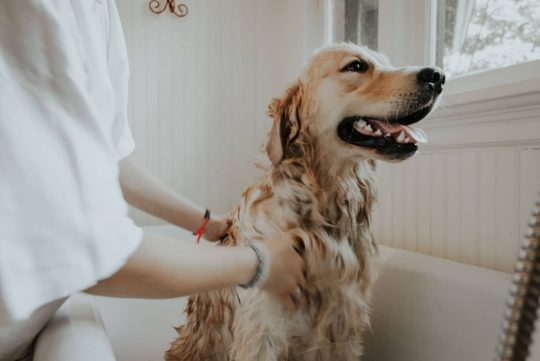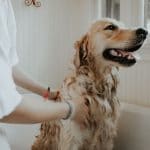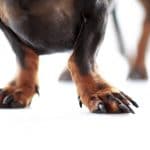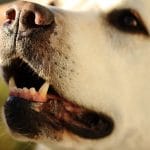Brushing
Brushing is a great way to bond with your dog, and it also makes your dog look clean and fresh. Some dogs love having their coat brushed – the right brush can feel like a massage on your dog’s skin.
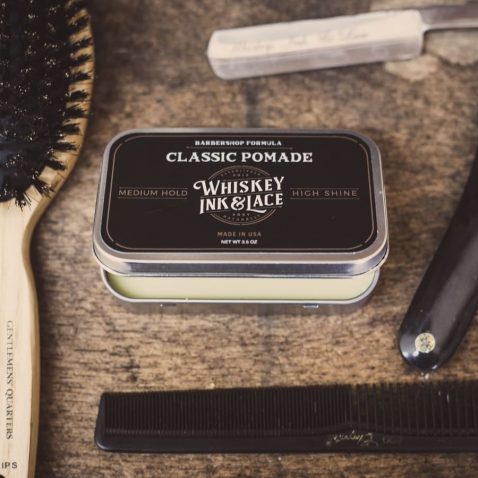
Why Do I Need to Brush My Dog’s Coat?
Brushing your dog’s fur is important for many reasons. Firstly, regular brushing removes dead fur from your dogs’ coat, meaning there’ll be less loose fur on your carpets and sofa!
It can also help distribute the natural oils that your dog’s skin releases, keeping his coat nice, shiny and healthy.
How Do I Brush My Dog?
- Prepare your dog for brushing – give him treats to get him to calm down if necessary
- Begin brushing in the direction of the hair growth, starting at the root of the hair with each brush
- When brushing, look out for fleas, ticks, lumps, cuts, and any other abnormalities
- Brush the main body, and then move on to legs, feet and tail and head
- After brushing a few times, you’ll get to know your dog’s coat and get to know how often he needs brushing
- Repeat when needed
How Often Should I Brush My Dog’s Fur?
The frequency in which you should brush your dog’s fur comes down to the type of fur he has. Longer haired breeds like Collies and Shih Tzu’s need to be brushed weekly at least – even more if the coat is matted or tangled.
If your dog has short fur, he won’t need to be brushed as often, as his fur is unlikely to knot and tangle. It’s best to give them a thorough brushing every couple of weeks though, just to remove any dead fur.
What if My Dog’s Fur is Matted?
It’s important to get rid of any mats in your dog’s fur as soon as you notice it. Matted fur in dogs can cut off circulation, cause skin infections, and cause your dog a lot of discomfort.
Bathe your dog (see Chapter 2: Bathing) and comb the knots out while the fur it wet. If you’re having no luck, then spray some pet-friendly detangling spray, wait for 10 minutes, and try again.
If the matting is too bad for you to deal with, take him to a groomer – they have more experience and tools to make the experience as pain-free for your dog as possible.
Tips
- Check for fleas when brushing!
- Be sure to check which brush is best for your dog’s fur type
- Don’t forget the ears, tail, and feet!
- Brush before and after bathing your dog
Bathing
All dogs will need a bath at some point, and it’s best to know how to do so. Baths can be scary experiences for dogs, so keep reading for some tips on how to give your dog a bath, and why it’s important to do so.
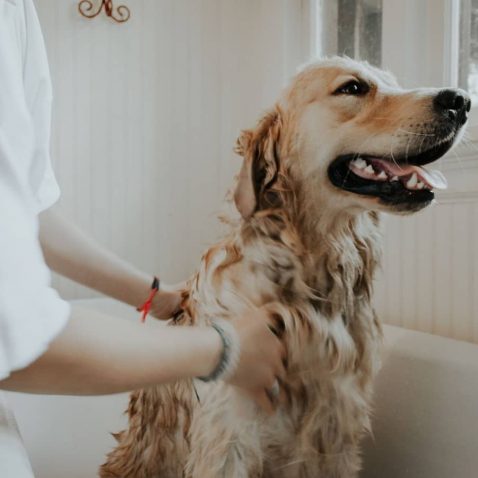
Why Do I Need to Bathe My Dog?
Bathing should be a regular part of your dog’s routine. Not only does bathing your dog stop him from smelling and looking dirty, but it’s also necessary to avoid skin issues such as fungal and bacterial problems. Regular bathing can also help get rid of parasites.
Please bear in mind that too much bathing can strip your dog of his natural oils – so only bathe him when you think it’s necessary!
How Often Should I Give My Dog a Bath?
After bathing your dog a few times, you’ll start to notice how often you need to give him a bath. The standard guideline is around once a month, but really you should give him a bath when he starts to smell, or when his fur gets dirty.
If you take him for a walk and he ends up rolling around in a puddle, then it’s probably best to give him a bath when you get in!
It really depends on your dog. If he’s a mucky pup or a working dog, he’ll need more baths than a dog that prefers to say indoors and relax.
Dogs with short hair and smooth coats tend to need bathing less often than those with longer fur.
Older dogs may need to be bathed more frequently, as they may find it more difficult to wash and groom themselves.
How Do I Bathe My Dog?
- Brush any knots out of your dog’s fur
- Use lukewarm water, and check its temperature on the inside of your wrist (too hot and it will burn him!)
- Use dog shampoo (people shampoo may dry his skin out), and massage all over your dog’s body. Make sure you don’t get any in their eyes or mouth!
- Rinse the shampoo out thoroughly (any left in may irritate your dog’s skin)
- If your dog’s fur is super knotty or tough, consider using a dog conditioner
- Dry your dog – it’s best to let him air dry as hair dryers can burn and scare your dog
- If he’s been a good boy, reward him with praise and petting!
Tips
- Use a dog shampoo suited to your dog’s needs
- Talk to your dog in a calm voice while bathing him
- Brush before and after bathing
- Use a bathmat! It will help prevent slipping
- Keep the water lukewarm – too hot or too cold will scare your dog away
- If your dog is being boisterous, try using a bath toy to keep him occupied
Clipping Nails
Cutting your dog’s nails is a vital part of their grooming routine. I’m yet to meet someone who enjoys cutting their dog’s nails – it’s never a fun experience for you or your dog, but it’s a necessary one.
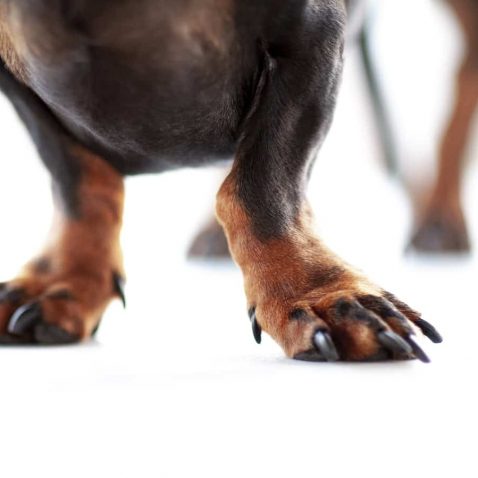
Why Do I Need to Clip My Dog’s Nails?
Most dogs spend a lot of time outdoors, and their nails will wear down naturally. Not all dogs spend enough time outdoors, and these dogs will need regular nail clipping sessions.
Long nails are a pain for both you and your dog. When your dog’s nails get too long, they can scratch the floors and furniture and even your skin.
When the nails are so long that they’re constantly touching the ground, it puts pressure on your dog’s feet and toe joint, which can cause pain and discomfort for your dog. Imagine wearing shoes
that are too tight – that’s how your dog feels when his nails are too long.
When left to grow too long, the nail can actually curve and grow into the pad of the foot, or get torn and split – either one can cause your dog great pain.
It’s best to keep your dog’s nails at a short length at all times, checking when they need cutting whenever you brush your dog.
How Do I Clip My Dog’s Nails?
- Hold your dog’s paw steadily yet gently (it’s always best to have a helper)
- Use scissors to trim down and long hair around the nails
- Make a note of where the quick is – if necessary, shine a light to see the pinky-red area that you need to avoid
- If your dog has dark claws, cut the nails in several small cuts to avoid the quick
- Cut the claw within around 2mm of the quick – cutting into the quick will cause bleeding and pain for your dog
- Don’t forget to cut your dog’s dewclaws if he has any (the dewclaw is the nail located slightly further up your dog’s leg)
It can be a tough task clipping your dog’s nails, so if it’s too difficult for you, call and arrange an appointment with a vet or dog groomer.
Tips
- Find out which type of clipper is best for your dog – guillotine or scissor types are the most popular
- Use an emery board after cutting to file down and sharp bits
- Shine a light to help you see the quick
- Be careful not to squeeze your dog’s toes! It will hurt them
- Don’t panic if you see blood – just dip the paw in cornstarch to stop the bleeding
- Keep giving your dog hugs and treats to keep him calm
Dental Care
You should take care of your dog’s mouth the same way you take care of your own. A healthy diet, chew toys and regular brushing can go a long way toward keeping your dog’s mouth nice and healthy.
Gum disease is the most frequently diagnosed condition in dogs, so be sure to take care of your dog’s mouth!
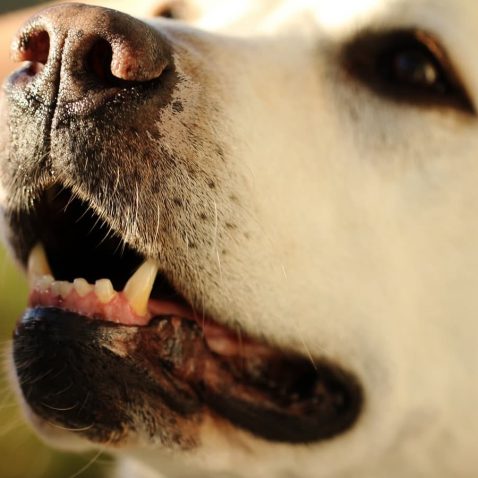
Why Is Dental Care Important for Dogs?
If you don’t keep your dog’s teeth clean, the plaque will build up and turn into tartar. Tartar is formed by the plaque mixing with minerals in your dog’s saliva and is brown and rough.
Tartar can lead to bad breath and gum inflammation, and worse cases can lead to gingivitis and gum disease which can be super painful for your pooch.
It’s estimated that over 80% of dogs over the age of three have oral diseases – prevention is key!!!
Just like us, dog’s need regular dental care for:
- Preventing the buildup of plaque and tartar
- Checking for (and preventing) gingivitis and gum disease
- Keeping an eye out for fractures or broken teeth
- To avoid bad breath
Remember, regular brushing will save you hundreds of dollars in veterinary bills!
How Do I Brush My Dog’s Teeth?
- Choose an appropriate toothbrush – make sure it isn’t too big for your dog’s mouth!
- Wet the toothbrush and put a tiny bit of dog toothpaste onto the brush (not human toothpaste, it can irritate your dog’s stomach)
- Start brushing the teeth lightly, brushing your dog’s lip up to get to the canines
- Start brushing further back – if your dog reacts negatively, try again another time (you don’t want to get bitten!)
- Once your dog is comfortable with having his teeth brushed, you should be able to get all the teeth and brush more rigorously with time
Tips
- Keep brushing sessions short but frequent
- Don’t start with the incisors as that area is sensitive to dogs
- Prevention is key – look out for swollen gums, difficulty eating, and bad breath
- Chew toys and certain dry foods can be great at keeping teeth and gums healthy
- Invest in dental dog treats!
- Ensure your dog has a balanced, nutritious diet! Raw meat, for example, can act as a natural toothbrush
- Feel for any lumps or bumps – anything out of the ordinary, be sure to get it checked by a veterinarian
Summary
Anything too difficult or that you’re not comfortable with, don’t be afraid to call the vet or groomer and book an appointment.
Home grooming can be cheaper and more convenient, but it’s important that both you and your dog are safe and comfortable.
You should regularly groom your dog to keep him looking clean, and to prevent other health issues that can be caused by bad hygiene. It can be difficult at first, but once you and your dog have a routine set up, it will be so much easier.
Hopefully, this guide has given you the information you need to groom your dog with ease!
Are there any tips we have left out, or are there any suggestions you want to share with us? Let us know in the comments below, and don’t forget to share this with your fellow dog-lovers!
Happy grooming!
Share the Love
If you found this post useful, please let others know about it by sharing it.
